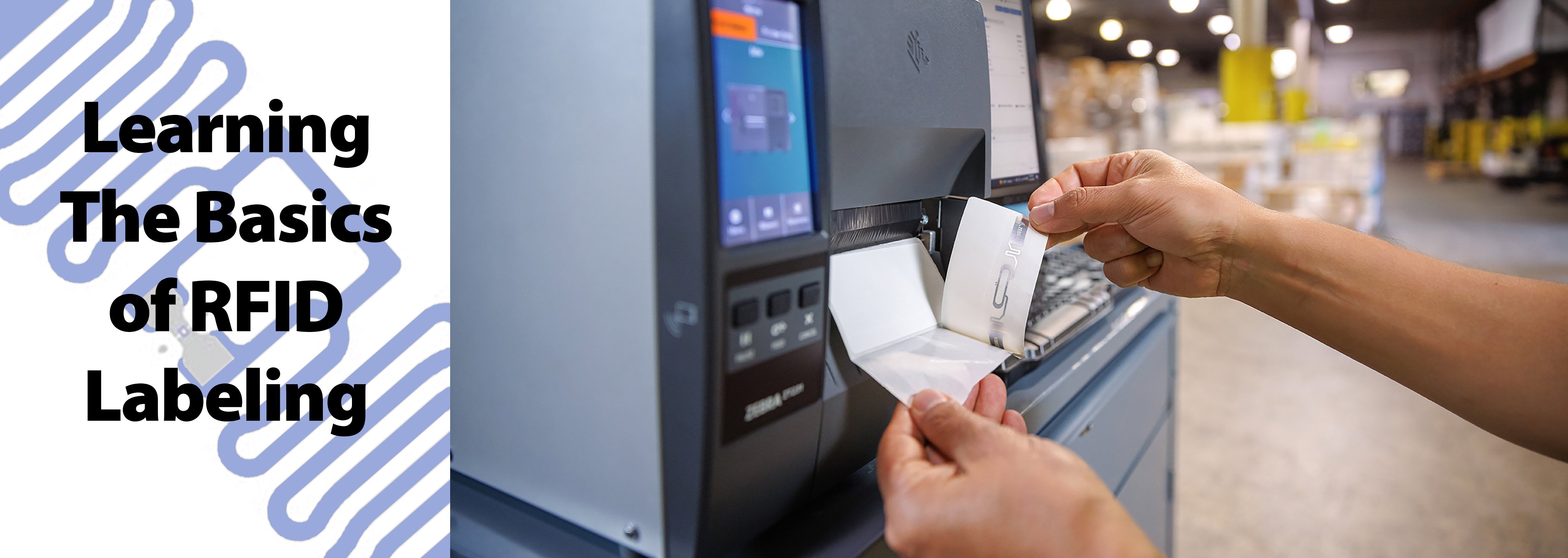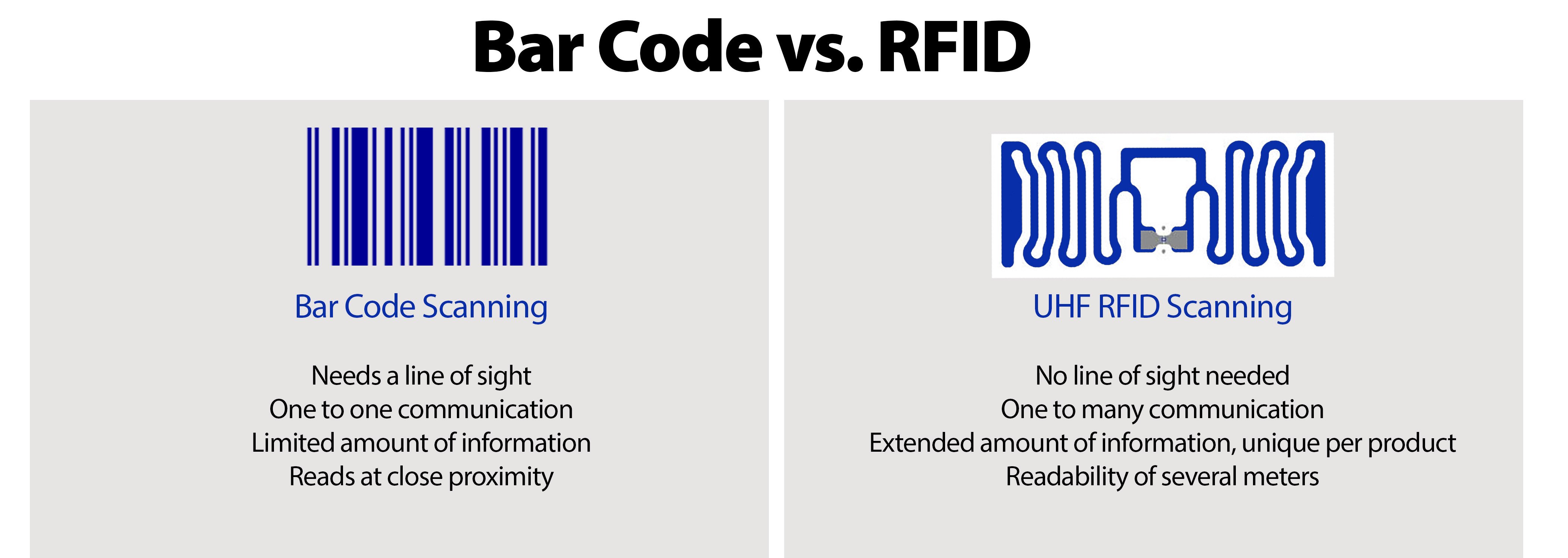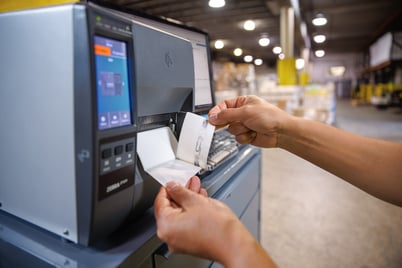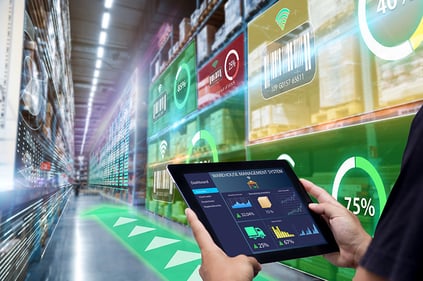
A Look at RFID - 101
RFID technology takes simple bar code labeling to the next level by imbedding information into a chip on a label that can be read with scanners quickly and in large batches, even while in motion.
Why is this important?
Imagine if you have a shipment of material coming into your warehouse on pallets. Instead of having to scan the bar code on each box, you can pass the pallet past an RFID scanner and it will read all the data on the labels on the boxes instantly. It’s exponentially faster than manually scanning each box.
Let’s start at the beginning.
What is an RFID label?
Radio Frequency Identification (RFID) technology uses radio frequencies to transmit data wirelessly for identifying objects affixed or implanted with tags or chips. These tags contain information about the object or merchandise.
An RFID label is a special type of label that contains a tiny computer chip and a small antenna built into an inlay that it sandwiched together inside a label. The chip stores data, such as an identification number or a unique code, and the antenna allows the chip to transmit and receive radio waves.

How does an RFID label work?
When an RFID label is placed within the range of an RFID reader, the reader sends out a radio signal that is picked up by the label’s antenna. The signal powers the chip in the label, which then sends back its data to the reader.
Types of RFID labels
There are two main types of RFID labels: passive and active. Passive RFID labels do not have their own power source, and they rely on the energy from the reader’s radio signal to transmit their data. Active RFID labels have a battery, which allows them to transmit their data over longer distances and at a faster rate.
Applications of RFID labels
RFID labels are used in a variety of applications, including:
• Inventory tracking: RFID label can be used to track the movement of products through a supply chain. This can help to improve inventory accuracy and reduce losses.
• Access control: RFID labels can be used to control access to restricted areas. This can be used to improve security and prevent unauthorized access.
• Animal tracking: RFID labels can be used to track the movement of animals. This can be used to improve animal welfare and prevent animal theft.
• Logistics: RFID labels can be used to track the movement of goods in transit. This can help to improve efficiency and reduce the risk of lost or damaged goods.
Benefits of RFID labels
RFID labels offer a number of benefits over traditional barcodes, including:
• Increased accuracy: RFID label can be read from a distance, which eliminates the need for line-of-sight scanning. This can improve the accuracy of inventory counts and reduce errors.
• Real-time tracking: RFID labels can be read in real time, which provides businesses with up-to-date information about the location of their assets. This can help to improve efficiency and reduce costs.
• Enhanced security: RFID labels can be used to create a secure perimeter around restricted areas. This can help to prevent unauthorized access and protect assets from theft.
What is needed to implement an RFID label for my products?
 Here are the main components needed to implement an RFID labeling system:
Here are the main components needed to implement an RFID labeling system:
• RFID tags: These are the small devices that contain the data that will be tracked. There are two main types of RFID tags: passive and active. Passive tags do not have a battery, so they rely on the energy from the reader’s signal to transmit their data. Active tags have a battery, which allows them to transmit their data over longer distances and at a faster rate.
• RFID readers: These are the devices that scan the RFID tags and read their data. There are two main types of RFID readers: handheld and fixed. Handheld readers are portable devices that can be used to scan tags in a variety of locations. Fixed readers are installed in a specific location and are used to scan tags as they pass by.
• RFID antennas: These are the devices that transmit and receive the radio waves that are used to communicate with the RFID tags. Antennas are typically mounted near the RFID readers.
• RFID software: This is the software that is used to manage the RFID system. The software is used to configure the readers, antennas, and tags, as well as to collect and analyze the data that is collected from the tags.
In addition to these main components, there are a number of other factors that need to be considered when implementing an RFID labeling system, such as:
• The environment: The environment in which the RFID system will be used will affect the type of tags, readers, and antennas that are needed. For example, if the system will be used in a harsh environment, such as a factory or warehouse, then durable tags and readers will be needed. RFID tag readability can also be affected by products that are dense or have an abundance of metal that might degrade the RFID signal.
• The application: The application for which the RFID system will be used will also affect the design of the system. For example, if the system will be used to track the movement of products through a supply chain, then a different type of system will be needed than if the system will be used to control access to a restricted area.
• The budget: The budget for the RFID system will also affect the design of the system. For example, if the budget is limited, then a simpler system may be needed.
Conclusion
RFID labels are a powerful technology that can be used to improve efficiency, accuracy, and security in a variety of applications. If you are considering using RFID labels, be sure to do your research to choose the right type of label for your needs.
Weber Packaging Solutions can help you get RFID labels and label applicators to meet your requirements.


